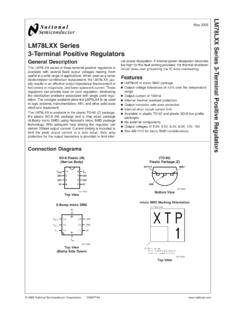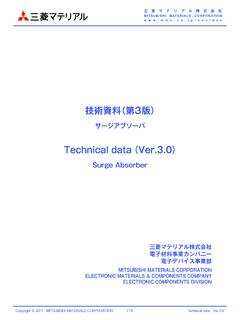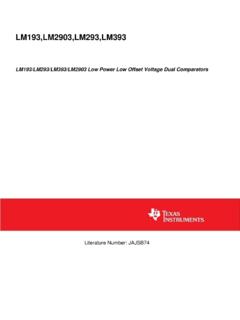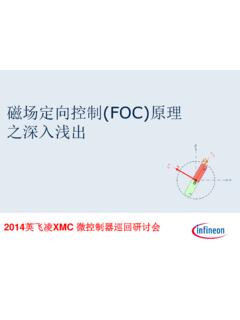Transcription of RENEWABLE ENERGY A. INTRODUCTION
1 RENEWABLE ENERGY . A. INTRODUCTION . RENEWABLE ENERGY (RE) resources are becoming increasingly important in the government's thrust to reduce dependence on fossil fuels and harmful emissions that affect health and the environment. RE includes biomass, geothermal, hydro, wind, solar and ocean ENERGY which can be converted into more useful ENERGY like electricity. These sources of ENERGY are RENEWABLE on a regular basis and their renewal rates are relatively rapid to consider their availability over an indefinite period of time. The utilization of RE contributes to the government's strategy to attain a 60 percent self-sufficiency level for total primary ENERGY by 2010.
2 At present, geothermal, hydro and biomass resources provide a combined 42. percent share. On the other hand, wind, solar and micro -hydro resources are getting wide-scale use, particularly for electrification in remote areas. B. RENEWABLE ENERGY SOURCES. Biomass Biomass refers to a non-fossilized, biodegradable organic material. In the Philippines, biomass technology varies with the use of biogas, bagasse, rice hull, coconut husks and shells, wood chips/residues and other agri-wastes. Landfill waste is another source of biomass. Urban centers like in Metro Manila, Cebu and Davao dispose substantial volumes of biodegradable domestic wastes. Several waste-to- ENERGY projects that use methane gas generated and captured from the landfills were approved by the Board of Investments.
3 Hydropower Hydropower is mostly derived from the potential ENERGY of dammed water which is harnessed to turn a water turbine that further drives a generator that produces electricity. Hydropower plants are classified based on their capacities, as follows: micro -hydro - 1 to 100 kW. Mini-hydro - 101 kW to 10 MW. Large hydro - more than 10 MW. The Philippines has many rivers, lakes, waterfalls, irrigation canals, springs, ponds and other water bodies that have vast hydropower potential. Depending on the volume and kinetic ENERGY of the falling or running water many of these water sources are technically feasible for development of micro - mini- or large hydropower projects.
4 Geothermal Geothermal power is derived from thermal ENERGY , usually occurring in deep reservoirs of hot fluids within the earth's crust. Unlike other types of RENEWABLE ENERGY , geothermal ENERGY is considered a mineral resource and upstream geothermal activities are essential to start a geothermal power project. These activities include the exploration of geothermal areas which involves a drilling program and a well field construction and extraction of steam from the area. There are four elements in a geothermal system, namely: 1. Heat source - which is the magma that comes close to the surface of the earth in volcanic areas 2. Permeable underground reservoir rock - which can hold or store water Industry Studies Department 1.
5 Board of Investments RENEWABLE ENERGY . 3. Solid cap rock - which maintains pressure and does not allow the heat, water or steam to escape 4. Water - which serves as the medium for carrying the heat The presence of a geothermal resource is indicated by volcanoes, hot springs, fumaroles (an opening on earth's crust which emits steam and gasses) and solfataras (volcanic area that gives off sulfurous gases and steam). Due to its location in the Ring of Fire , the Philippines is one of the largest producers of geothermal ENERGY in the world (second only to the US in terms of installed capacity). Wind ENERGY Wind ENERGY is derived from wind that is converted into useful electrical or mechanical ENERGY .
6 Like old- fashioned windmills, today's wind machines ( , wind turbines) use blades that are rotated by the wind's kinetic ENERGY . The blades are connected to a drive shaft that turns an electric generator to produce electricity. Solar ENERGY Solar ENERGY is derived from solar radiation which is converted into useful electrical or thermal ENERGY . Solar power systems can be classified into two general categories Photovoltaic (PV) and Concentrating Solar Power (CSP) systems. A PV system that converts solar ENERGY into an electrical ENERGY includes a solar photovoltaic plant that uses polycrystalline silicon solar panels exposed on a wide area. Ocean ENERGY Ocean ENERGY is derived from ocean or tidal current or wave ENERGY that is converted into useful electrical or mechanical ENERGY .
7 Due to its archipelagic nature, the Philippines has a big potential for ocean ENERGY where the potential theoretical capacity is estimated to be about 170,000 MW. C. POWER GENERATING CAPACITY. Installed Capacity As of 2010, the total installed capacity of the Philippines' power generating plants was recorded at 16,359 MW. The largest share was attributed to coal-fired power. Hydro and geothermal power plants are making substantial shares. Other RENEWABLE ENERGY such as wind, solar, and biomass still account for less than 1 percent of the total generation capacity. 2010 Installed Generation Capacity Source: Power Statistics 2010, DOE. Industry Studies Department 2.
8 Board of Investments RENEWABLE ENERGY . D. POWER DEVELOPMENT SCENARIO. The following shows the progressive ENERGY requirement of the Philippines until 2030: Additional Capacities, 2009 - 2030. ( RENEWABLE and Non- RENEWABLE ENERGY ). LUZON - 11,900 MW. VISAYAS-2,150 MW. MINDANAO 2,500 MW. Total Additional Capacity Needed - 16,550 MW. The total target capacities for RE are as follows: 2008 EXISTING TARGET TOTAL. RESOURCE. CAPACITY (MW) CAPACITY IN 2030. Geothermal 2,027 1,070 3,097. Hydro 3,367 3,400 6,767. Wind 33 515 548. Solar 5 30 35. Biomass 68 200 268. Ocean 0 120 120. Total 5,500 5,355 10,235. RE Projects for Partnership/Private Sector Participation RESOURCE (MW) REMARKS.
9 O 8 projects ranging from 7 MW to 360 MW. Hydro 638 o Estimated project cost of US$ 932 million o Implementation Schedule : 2012 - 2020. o 5 projects at 40 MW each Geothermal 200 o Estimated project cost of US$ 1 billion o Implementation Schedule : 2013 - 2019. o 6 projects ranging from 5 MW to 46 MW. Wind 213 o Estimated project cost of US$ million o Implementation Schedule : 2011 - 2014. o 7 projects ranging from MW to 35 MW. Biomass 172 o Estimated project cost of US$ 247 million o Implementation Schedule : 2012-2017. Source: PPP book November 2010 issue. Industry Studies Department 3. Board of Investments RENEWABLE ENERGY . E. PHILIPPINE ADVANTAGE.
10 Support infrastructure High voltage backbone system of interconnected transmission lines, sub-stations and related facilities exist in Luzon and Visayas, and another in Mindanao. The transmission lines traversing the entire country have a total line length of 19,778 circuit kilometers, while the total sub-station capacity is at 24,643 megavolts amperes (MVA). SUBSTATION CAPACITIES CIRCUIT KILOMETER. GRID. (MVA) (ckt-km). Luzon 19,271 9,527. Visayas 3,269 4,745. Mindanao 2,103 5,506. Total 24,643 19,778. National Grid Corporation of the Philippines (NGCP) is responsible for the planning, construction and centralized operation and maintenance of high-voltage transmission facilities, including grid interconnection and ancillary services Human resources Manpower Requirement Engineers Plant Operators Maintenance personnel Administrative staff Monthly Salary Range Engineers US$ 833 to US$ 854.










